名词复数和动词三单练习
名词变复数、动词三单形式现在分词过去分词过去式变化及形容词副词级别变化
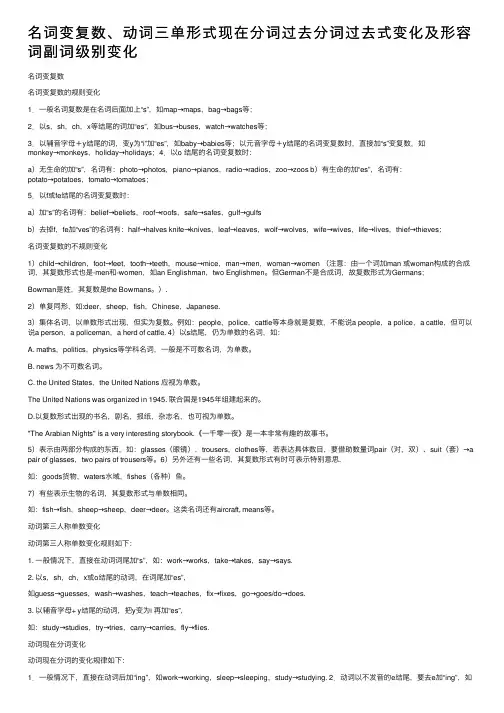
名词变复数、动词三单形式现在分词过去分词过去式变化及形容词副词级别变化名词变复数名词变复数的规则变化1.⼀般名词复数是在名词后⾯加上“s”,如map→maps,bag→bags等;2.以s,sh,ch,x等结尾的词加“es”,如bus→buses,watch→watches等;3.以辅⾳字母+y结尾的词,变y为“i”加“es”,如baby→babies等;以元⾳字母+y结尾的名词变复数时,直接加“s”变复数,如monkey→monkeys,holiday→holidays;4.以o 结尾的名词变复数时:a)⽆⽣命的加“s”,名词有:photo→photos,piano→pianos,radio→radios,zoo→zoos b)有⽣命的加“es”,名词有:potato→potatoes,tomato→tomatoes;5.以f或fe结尾的名词变复数时:a)加“s”的名词有:belief→beliefs,roof→roofs,safe→safes,gulf→gulfsb)去掉f,fe加“ves”的名词有:half→halves knife→knives,leaf→leaves,wolf→wolves,wife→wives,life→lives,thief→thieves;名词变复数的不规则变化1)child→children,foot→feet,tooth→teeth,mouse→mice,man→men,woman→women (注意:由⼀个词加man 或woman构成的合成词,其复数形式也是-men和-women,如an Englishman,two Englishmen。
但German不是合成词,故复数形式为Germans;Bowman是姓,其复数是the Bowmans。
).2)单复同形,如:deer,sheep,fish,Chinese,Japanese.3)集体名词,以单数形式出现,但实为复数。
名词单复数动词第三人称单复数练习题
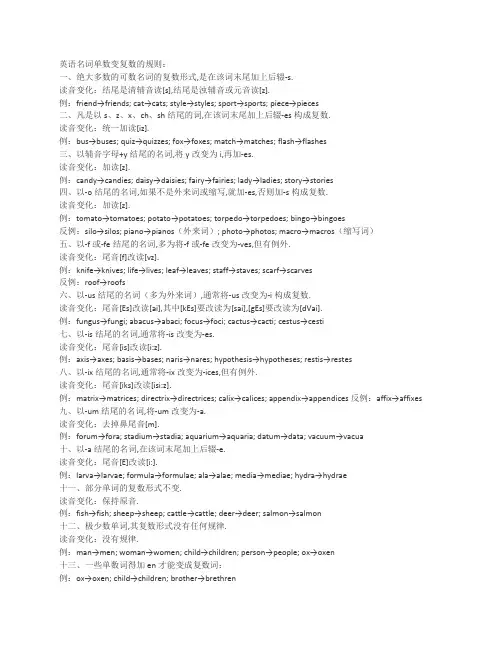
英语名词单数变复数的规则:一、绝大多数的可数名词的复数形式,是在该词末尾加上后辍-s.读音变化:结尾是清辅音读[s],结尾是浊辅音或元音读[z].例:friend→friends; cat→cats; style→styles; sport→sports; piece→pieces二、凡是以s、z、x、ch、sh结尾的词,在该词末尾加上后辍-es构成复数.读音变化:统一加读[iz].例:bus→buses; quiz→quizzes; fox→foxes; match→matches; flash→flashes三、以辅音字母+y结尾的名词,将y改变为i,再加-es.读音变化:加读[z].例:candy→candies; daisy→daisies; fairy→fairies; lady→ladies; story→stories四、以-o结尾的名词,如果不是外来词或缩写,就加-es,否则加-s构成复数.读音变化:加读[z].例:tomato→tomatoes; potato→potatoes; torpedo→torpedoes; bingo→bingoes反例:silo→silos; piano→pianos(外来词); photo→photos; macro→macros(缩写词)五、以-f或-fe结尾的名词,多为将-f或-fe改变为-ves,但有例外.读音变化:尾音[f]改读[vz].例:knife→knives; life→lives; leaf→leaves; staff→staves; scarf→scarves反例:roof→roofs六、以-us结尾的名词(多为外来词),通常将-us改变为-i构成复数.读音变化:尾音[Es]改读[ai],其中[kEs]要改读为[sai],[gEs]要改读为[dVai].例:fungus→fungi; abacus→abaci; focus→foci; cactus→cacti; cestus→cesti七、以-is结尾的名词,通常将-is改变为-es.读音变化:尾音[is]改读[i:z].例:axis→axes; basis→bases; naris→nares; hypothesis→hypotheses; restis→restes八、以-ix结尾的名词,通常将-ix改变为-ices,但有例外.读音变化:尾音[iks]改读[isi:z].例:matrix→matrices; directrix→directrices; calix→calices; appendix→appendices反例:affix→affixes 九、以-um结尾的名词,将-um改变为-a.读音变化:去掉鼻尾音[m].例:forum→fora; stadium→stadia; aquarium→aquaria; datum→data; vacuum→vacua十、以-a结尾的名词,在该词末尾加上后辍-e.读音变化:尾音[E]改读[i:].例:larva→larvae; formula→formulae; ala→alae; media→mediae; hydra→hydrae十一、部分单词的复数形式不变.读音变化:保持原音.例:fish→fish; sheep→sheep; cattle→cattle; deer→deer; salmon→salmon十二、极少数单词,其复数形式没有任何规律.读音变化:没有规律.例:man→men; woman→women; child→children; person→people; ox→oxen十三、一些单数词得加en才能变成复数词:例:ox→oxen; child→children; brother→brethren十四、一些单数词得改头换面一番,才能变成复数词例:analysis→analyses分析; basis→bases基础; datum→data数据; foot→feet;formula→formulae/formulas公式; goose→geese; louse→lice虱子; man→menmouse→mice; medium→media/mediums媒介; memorandum→memoranda/memorandums备忘录; parenthesis→parentheses圆括号; phenomenon→phenomena现象; radius→radii半径tooth→teeth; woman→women十五、有些名词是单数、复数不分的例:deer; fish; cannon; sheep; salmon 鲑鱼; trout 鳟鱼十六、一些名词虽分单数、复数,但出现次数多的总是单数词例:abscence; clothing; film; help; furniture家具; machinery机械; news; scenery风景; sugar;traffic交通十七、另一些名词则以复数词出现的机会较多例:bellows风箱; clothes; police; shorts短裤; scissors剪刀; spectacles眼镜; shears大剪刀trousers长裤; wages工资十八、compound nouns,这类复数词是以主要的名词来表示例:daughter-in-law→daughters-in-law媳妇; father-in-law→fathers-in-law岳父man-of-war→men-of-war兵舰; maid-servant→maid-servantsstep-son→step-sons晚子; son-in-law→sons-in-law十九、若表达具体数目,要借助数量词例:pair(对,双); suit(套); a pair of glasses; two pairs of trousers二十、另外还有一些名词,其复数形式有时可表示特别意思,例:goods货物,waters水域,fishes(各种)鱼二十一、除人民币元、角、分外,美元、英镑、法郎等都有复数形式.例:adollar,two dollars; a meter,two meters第三人称单数第三人称单数是英语中的一种语法,也称“三单”或“单三”,用于一般现在时的句子,当动词在第三人称单数后时【she、he 、it、不可数名词和人名(一个人的)】,要根据其情况变化。
can,be动词,名词变复数,三单用法
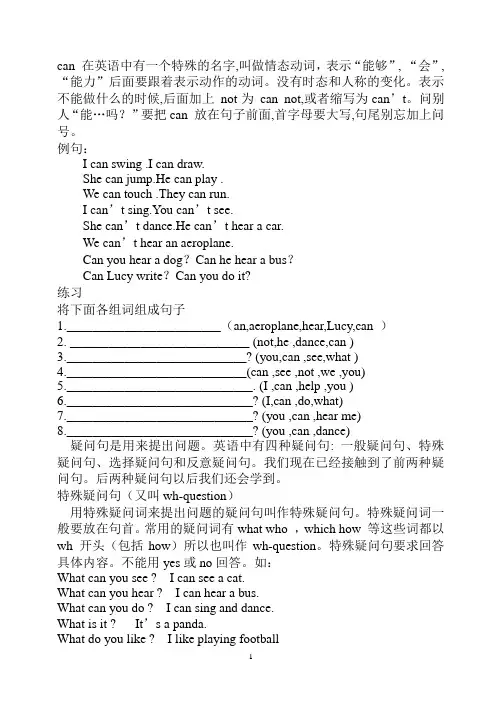
can 在英语中有一个特殊的名字,叫做情态动词,表示“能够”, “会”, “能力”后面要跟着表示动作的动词。
没有时态和人称的变化。
表示不能做什么的时候,后面加上not为can not,或者缩写为can’t。
问别人“能…吗?”要把can 放在句子前面,首字母要大写,句尾别忘加上问号。
例句:I can swing .I can draw.She can jump.He can play .We can touch .They can run.I can’t sing.You can’t see.She can’t dance.He can’t hear a car.We can’t hear an aeroplane.Can you hear a dog?Can he hear a bus?Can Lucy write?Can you do it?练习将下面各组词组成句子1.________________________(an,aeroplane,hear,Lucy,can )2. ____________________________ (not,he ,dance,can )3.____________________________? (you,can ,see,what )4.____________________________(can ,see ,not ,we ,you)5._____________________________. (I ,can ,help ,you )6._____________________________? (I,can ,do,what)7._____________________________? (you ,can ,hear me)8._____________________________? (you ,can ,dance)疑问句是用来提出问题。
英语动词单三变化规则及名词单数变复数口诀知识讲解
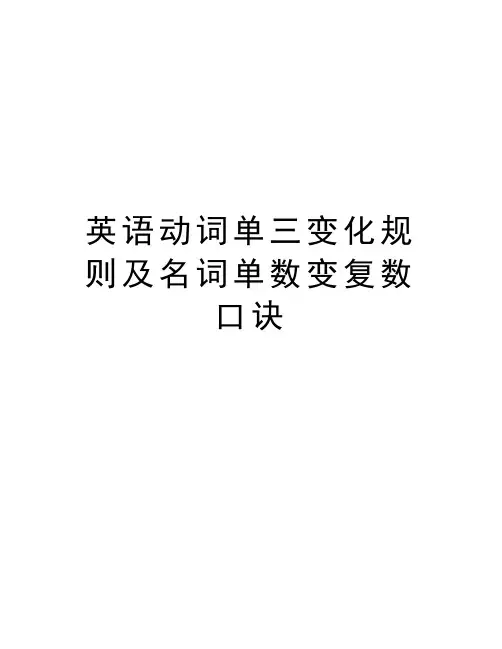
英语动词单三变化规则及名词单数变复数口诀英语动词第三人称单数变化规则及名词单数变复数口诀一、动词的第三人称单数现在式变化规则:1)一般由动词原形加-sget-gets play-plays2)以e结尾的动词,加-slike-likes make-makes3)以o结尾的动词加-esgo-goes do-does4)以s, x, ch, sh等字母结尾的动词,后面加-eskiss-kisses fix-fixes teach-teaches fish-fishes 5)以辅音字母加y结尾的动词,先将y变i, 再加-esfly-flies study-studies6) have –has1、一般现在时①主语+动词原型VI have a friend. You have a friend. We have a friend.They have a friend.②主语(第三人称单数)+动词V(三单)She / He / It has a friend.Tom / My mother has a friend.2.不规则动词过去式与过去分词分类记忆表(一)、AAA. (原形,过去式和过去分词一致)1. 花费 cost cost cost2. 割 cut cut cut3. 伤害 hurt hurt hurt4. 让 let let let5. 放 put put put6. 朗读 read read read7. 设置 set set set 8.打击,碰撞 hit hit hit9.关上门窗 shut shut shut 10.让 let let let(二)、ABB(过去式和过去分词一致)1) 过去式、过去分词含有-ought1. 带来 bring brought brought2. 买 buy bought bought3. 打架 fight fought fought4. 想 think thought thought5. 寻找、探究 seek sought sought2) 过去式、过去分词含有-aught5. 抓住 catch caught caught6. 教 teach taught taughtt替换原形-d3) 过去式、过去分词-7. 建筑 build built built 8. 借出 lend lent lent9. 花费 spend spent spent 10.派遣 send sent sent 4) 过去式、过去分词在原形词尾加t或d11. 学会 learn learnt/ed learnt/ed 12. 意思 mean meant meant13. 燃烧 burn burnt/ed burnted 13. 做梦 dream dreamt/ed dreamt/ed 13. 处理 deal dealt dealt14. 听 hear heard heard5) 过去式、过去分词改为-ept15. 保持 keep kept kept 16. 睡觉 sleep slept slept17. 扫 sweep swept swept6) 过去式、过去分词改为-elt18. 感觉 feel felt fel 19. 嗅 smell smelt/ed smelt/ed 20. 拼写 spell spelt/ed spelt/ed 7) 过去式、过去分词改为-aid20. 孵蛋 lay laid laid 21. 说 say said said 22. 支付 pay paid paid8) 过去式、过去分词改为-old23. 卖 sell sold sold24. 告诉 tell told told9) 过去式、过去分词改为-ood25 站 stand stood stood26.明白 understand understood understood10) 其它变化27.得到 get got got(gotten) 28.坐 sit sat sat29.照顾 babysit babysat babysat 30.离开 leave left left31.失去 lose lost lost 32.找到 find found found33.有 have(has) had had 34.握住,召开 hold held held35.制造 make made made 36.悬挂 hang hung hung37.照耀 shine shone shone 39.赢 win won won40逃跑 flee fled fled 41喂feed fed fed42.引导,导致 lead led led 43遇见 meet met met三、ABA (过去式与原形一致)1.变成 become became become2. 来 come came come3. 跑 run ran run 四、ABC (原形、过去式、过去分词各不一样)1). 过去分词在过去式或原形后加-n或-en1. 击败 beat beat beaten2. 破坏 break broke broken3. 驾驶 drive drove driven4. 吃 eat ate eaten5. 落下 fall fell fallen6. 给 give gave given7. 生长 grow grew grown8. 知道 know knew known9. blow blew blown10. 扔 throw threw thrown11. 展示 show showed shown12.弄错,错误 mistake mistook mistaken 13. 拿 take took taken14.摇动 shake shook shaken 15. 说 speak spoke spoken16. 选择 choose chose chosen2) 三种形式都有变化1. 是 be( is, am, are ) was/were been2. 开始 begin began begun3. 做 do did done4. 喝 drink drank drunk5. 飞fly flew flown6. 忘记 forget forgot forgotten(forgot)7. 躺 lie lay lain8. 骑 ride rode ridden 9. 打电话 ring rang rung10. 唱 sing sang sung 11. 穿 wear wore worn 12. 游泳 swim swam swum 13. 写 write wrote written 14. 去 go went gone语法(Grammar)一、现在完成时的构成现在完成时的构成:助动词 have (has)+动词的过去分词过去分词的构成方法如下 : A:1.一般情况下,直接在动词原形后面加–ed. worked answered obeyed wanted 2.以不发音的 -e 结尾的动词只加–d. moved hoped divided3.字尾是辅音+y的动词。
时态:动词第三人称单数形式与名词复数形式变化规则区别知识讲解
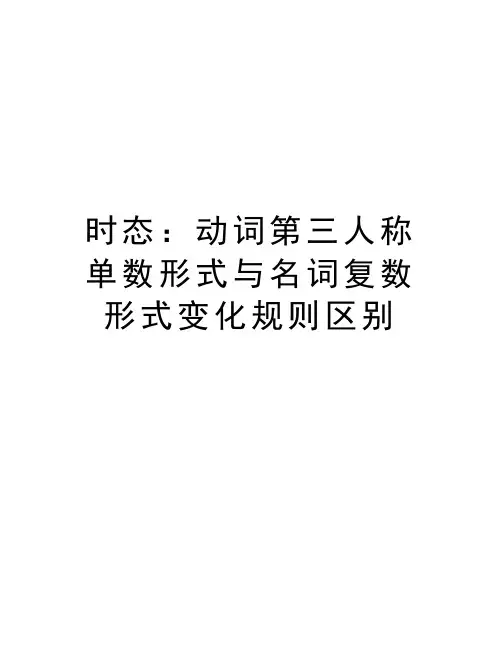
时态:动词第三人称单数形式与名词复数形式变化规则区别
名词复数形式与动词第三人称单数形式变化规则区别动词第三人称单数形式的变化规律跟名词复数变化规律相似,一般情况下加-s.但是,他们是截然不同的两个概念。
一、首先,他们两种不同的词性,概念不一样
二、其次,他们的变化规律也不一样
1.单复数同形﹕Chinese-Chinese, sheep- sheep, deer- deer, fish-fish
2.改变内变元音字母﹕foot-feet, tooth- teeth, goose-geese,
man- men, woman- women,
mouse- mice.
3.加字尾en或ren:ox- oxen, child- children
4.有些外来语保留原来的复数形式﹕bacterium – bacteria, phenomenon – phenomena
三、最后,他们所作的句子成分不一样。
例如:
I like playing the piano, and Tom likes(动词三单形式作谓语) flying kites(名词复数形式作宾语).。
动词三单形式练习40题
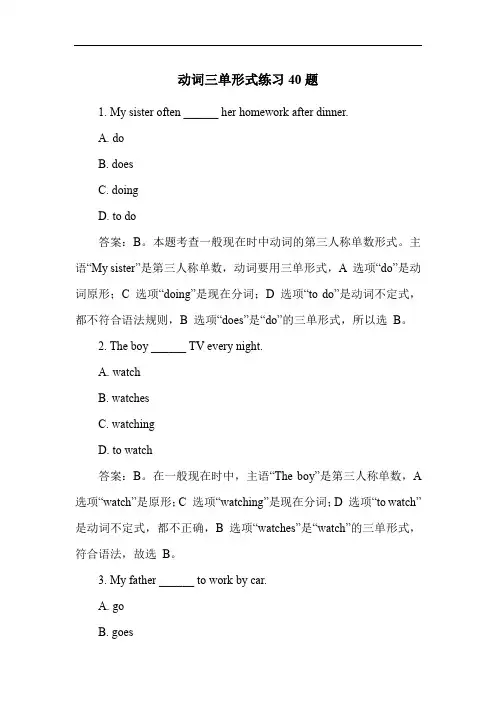
动词三单形式练习40题1. My sister often ______ her homework after dinner.A. doB. doesC. doingD. to do答案:B。
本题考查一般现在时中动词的第三人称单数形式。
主语“My sister”是第三人称单数,动词要用三单形式,A 选项“do”是动词原形;C 选项“doing”是现在分词;D 选项“to do”是动词不定式,都不符合语法规则,B 选项“does”是“do”的三单形式,所以选B。
2. The boy ______ TV every night.A. watchB. watchesC. watchingD. to watch答案:B。
在一般现在时中,主语“The boy”是第三人称单数,A 选项“watch”是原形;C 选项“watching”是现在分词;D 选项“to watch”是动词不定式,都不正确,B 选项“watches”是“watch”的三单形式,符合语法,故选B。
3. My father ______ to work by car.A. goB. goesC. goingD. to go答案:B。
“My father”是第三人称单数,A 选项“go”是原形;C 选项“going”是现在分词;D 选项“to go”是动词不定式,均不符合,B 选项“goes”是“go”的三单形式,所以选B。
4. Our teacher ______ very kind.A. isB. amC. areD. be答案:A。
主语“Our teacher”是第三人称单数,be 动词要用is,B 选项“am”用于I 之后;C 选项“are”用于复数主语;D 选项“be”是动词原形,均不合适,故选A。
5. She ______ sports every day.A. playB. playsC. playingD. to play答案:B。
名词单复数练习,动词三人称单数练习,动词ing练习
单元测验二(名词单复数与动词三单及动词ing )班级: _______________ 姓名: __________________ 得分: ____________一、请默写出名词单数变复数的变法规则:(10分)规则变化:1.2, 3, 4, 5,中日不变,以0结尾的单词,二、请写出下列名词的复数形式,没有复数形式的请划出/ °(25分)tree _______________ h orse ________________ bus __________________ f ox ________________ branch ___________ city _ _ countryfamily _ boy _________________________________ day _______ leaflifewoman zoobroomtooth juice_—foot. waterpeople, milkdeerox三、填入所给名词的正确形式.(5分) The ______________________ are playing football now. (child) There are ten ________________________________ in our school {woman teacher) Most of _________________ live in ________________ ・(German) There are three _________________________ and five ____________ Could you please give me some ________________________ (milk) 1> 2、 3、 4、 5、 四、请写出下列动词的三人称单数及现在分词形式。
(20分) Sit go _ run cry ■ watch say ■ dance see haveswim, make write_ study wash_ play draw do diefish mousein the room.(Chinese, German) stopsing五、用do does 填空。
动词过去式的变化_动词三人称单数练习_动词ing练习
动词的第三人称单数的单数及发音规则:1.一般直接在动词后加-s,-s在清辅音后读/s/,在浊辅音或元音后读/z/, ds 读/dz/, ts读/ts 如help -helps/s/ know -knows/z/ get -gets/s/ read -reads/z/2.以字母s, x, ch, sh或有些以o 结尾的动词加-es,-es 读/iz/, 如guess -guesses fix -fixes teach -teaches wash -washes注意:go goes/z/ do does /z/3.辅音字母+y结尾的动词,先变y为i,再加-es,-ies读/iz/carry -carries fly -flies study -studies注意:在play---plays,say----says中,字母y前为元音字母,第三人称单数形式直接在动词后加-s4.be动词的第三人称单数分别为am, is, are, have则为has注意:以不发音字母“e”结尾的开音节词,如果尾音是/s/,/z/,加-s后,字母”e”发音,与所加-s一起读作/iz/,如close closes/iz/动词的ing变化规则:1.一般情况直接加ing,如look—looking go---going visit---visiting2.以不发音的e结尾的,去e再加ing,如come---coming make---making write---writing3.以重读闭音节结尾并且只有一个辅音字母的,双写该辅音字母,再加ing,如run---running stop---stopping get---getting swim---swimming begin---beginning4.以辅音字母加y结尾的,直接加ing,如study---studying carry---carrying fly---flying cry---crying5.以ie结尾的重度开音节动词,先变ie为y,再加ing,如die---dying tie---tying lie---lying动词的过去式变化规则:1.规则变化(1)一般直接在动词后加ed,-ed在清辅音后读/t/, 在浊辅音及元音后读/d,/-ed在/t//d/后读/id/,如call---called open---opened look---looked want---wanted /id/ need---needed /id/(2)以不发音的“e”结尾的,直接加-d ,如live---lived move---moved hope---hoped(3)以辅音字母加y结尾的动词,先变y为i,再加-ed,(注意:如果是元音字母加y结尾的,还是直接加-ed,如,play---played,enjoy---enjoyed)如study---studied cry---cried try---tried(4)以一个辅音字母结尾的重读闭音节动词,双写最后一个辅音字母,再加-ed,如plan---planned fit---fitted stop---stopped2.不规则变化(要特俗记忆),以下是一些常见的动词的过去式am,is-was are-were, do-did, see-saw, say-said, give-gave, get-got,另附清辅音与浊辅音:清辅音:[p] [t] [k] [f] [s] [θ] [∫] [ts] [t∫] [tr] [h]浊辅音:[b] [d] [g] [v] [z] [δ] [з] [dz] [dз] [dr] [r]音节分为开音节和闭音节1.开音节又分为相对开音节和绝对开音节(1)相对开音节:“以一个元音字母+一个辅音字母(r除外)+不发音的e”结尾的叫相对开音节。
小升初英语名词复数和动词三单知识点及练习题
小升初英语名词复数和动词三单知识点及练习题1.一般情况下,直接加-s,如:book-books, bag-bags, cat-cats, bed-beds2.以s. x. sh. ch结尾,加-es,如:bus-buses, box-boxes, brush-brushes, watch-watches3.以“辅音字母+y”结尾,变y为i, 再加-es,如:family-families, strawberry-strawberries4.以“f或fe”结尾,变f或fe为v, 再加-es,如:knife-knives5.不规那么名词复数: man-men, woman-women, policeman-policemen, policewoman-policewomen, mouse-mice child-children foot-feet,.tooth-teeth fish-fish, people-people, Chinese-Chinese, Japanese-Japanese练习:写出以下各词的复数。
I him this her watch bookchild photo diary day foot dress tooth sheep box strawberry thief yo-yo peach sandwich man woman paper people1.一般情况下,直接加-s,如:cook-cooks, milk-milks2.以s. x. sh. ch. o结尾,加-es,如:guess-guesses, wash-washes, watch-watches, go-goes3.以“辅音字母+y”结尾,变y为i, 再加-es,如:study-studies练习: 写出以下动词的第三人称单数。
drink go stay make lookhave pass carry e watch plant fly study brush teach。
人教上语法名词单复数语法及练习
名词单复数名词:包括可数名词(如:pear ,tomato ,banana, carrot )和不可数名词(如:drink, beef, chicken, meat, coffee)修饰词: 做主语时:名词复数做主语时:可数名词单数变复数规则:1.a;an(名词首字母发音为元音),one 都表示一个 2.this(这个); that(那个) ;the (表示特定的某一个) 3.my,your 等形容性物主代词 可数名词单可数名词复数可数名词练习题:1.I want to buy some____________(tomato).2.There are two____________(potato)on the table.3.Eating too many______________(vegetable) is good for us.4.Milk and fish are good for your__________(tooth).6.The rabbit love to eat___________(胡萝卜)7.Please give me a kilo of__________(牛肉)8.There is __________(一个) onion in the bag.9.Don’t eat too much_________(盐).10.Too much____________(糖)isn’t good for your health.11.I like to eat________(fish).12.There are some________(fish)in the river .【答案】1.tomatoes 2.potatoes 3.vegetables 4.teeth 5.are6.carrots7.beef8. an9. salt 10. sugar 11. fish12. fishes 13. C知识点二:不可数名词修饰词 不可数名词做主语时too much:太多,后加不可数名词;too many: 太多,后加可数名词复数much too:太,表程度 some 和any 都可以修饰可数名词复数和不可数名词。
- 1、下载文档前请自行甄别文档内容的完整性,平台不提供额外的编辑、内容补充、找答案等附加服务。
- 2、"仅部分预览"的文档,不可在线预览部分如存在完整性等问题,可反馈申请退款(可完整预览的文档不适用该条件!)。
- 3、如文档侵犯您的权益,请联系客服反馈,我们会尽快为您处理(人工客服工作时间:9:00-18:30)。
1、写出下列各词的复数。
I ___________ him _________ this ________ her _________ watch_______ mango_______ child _______ photo _________ diary _______ day_________ foot________ dress _________ tooth_______ sheep ______ box_______ strawberry _____ peach______ sandwich______ man______ woman_______ knife _______ engineer_____ leaf_______ people________
2、用所给名词的正确形式填空。
(1)Are there two ( box ) on the table?
(2)I can see some ( people ) in the cinema.
(3)How many ( day ) are there in a week?
(4)Here’re five( bottle ) of ( juice ) for you
(5)This ( violin ) is hers. Those ( grape ) are over there.
3、选择题
1、There on the wall .They are very beautiful.
A. are photoes
B. are photos
C. is a photo
D. is photos
2、The old man wants .
A. six boxes of apples
B. six boxes of apple
C. six box of apples
D. six boxs of apples
3、There some in the river.
A. is ,fish
B. are, fishs
C. is, fishs
D. are ,fish
4、How many ______ do you see in the picture?
A. tomatos
B. tomatoes
C. tomato
D. the tomato
5、Do you want to drink much ?
A、a milk
B、milk
C、milks
6、In autumn,you can see a lot of on the ground.
A、leaf
B、leafs
C、leaves
7、______ and ______ are not friends.
A. Foxs…wolfs
B. Foxes…wolfs
C. Foxes…wolves
8、I was so hungry and I ate two ______.
A. bowls of noodle
B. bowls of noodles
C. bowl of noodles
9、I want to know why ______ are interested in action films(武打片).
A. the people
B. people
C. peoples
D. the peoples
10、They come from different ______
A. country
B. countries
C. a country
D. countrys
一、写出下列动词的第三人称单数
go ________ do ________ play ___ jump _________ swim _______ run __________ put _________ sing __________ dance ________ come _______ get _________ have __________
fly _________ study _________ read __________ look __________ walk _________ eat _________ like __________ draw ___________
二、用所给词的适当形式填空:
1. She ______(do) homework by herself.
2. Jack ______(go) home by bike.
3. The giant______(climb) up the beanstalk. 4 .Her mum ______(run) to the goose.
5. He______(do not)like apple. 6, Sam______(put) it under his arm.
7. The boy_______(chase) it. 8. Kitty______(watch)TV everyday.
9. He______(feed)them at 8:00 in the morning. 10. When ______(do)he get up?
11. Grandma Wang___(live) in Pudong. 12. The girls___(give) the key to Grandpa.
13. That key ______(open) the old box. 14.She ______(say) “I like these puppets”.
15.What_____(do)Alice find?
三、选择题
1. Ben_____a new book.
A.have
B.has
C.haves
D.were
2. Superdog________the boys
A.see
B.sees
C.seeing
D.ses
3. He____the beans in the ground.
A.buy
B.puts
C.put
D.buys
4. Sam’s bicycle ______a bell.
A.have B has C.having D.is having
5. I every day
A.swim
B.swims
C.swiming
D.swimes
6. He his homework every day.
A.does
B.do
C.are
D.is
7. I ________ my homework every day.
A.do
B.is
C.does
D.are
8.They ________ their homework every day.
A. do
B.does
C. is
D.are
9. Jack_______their cow.
A.sells
B.sell
C.selling
10. Lucy_______with her hands.
A.touch
B.touching
C.touches
D.touchs
11. Superdog________the boys
A.see
B.sees
C.seeing
D.ses。
